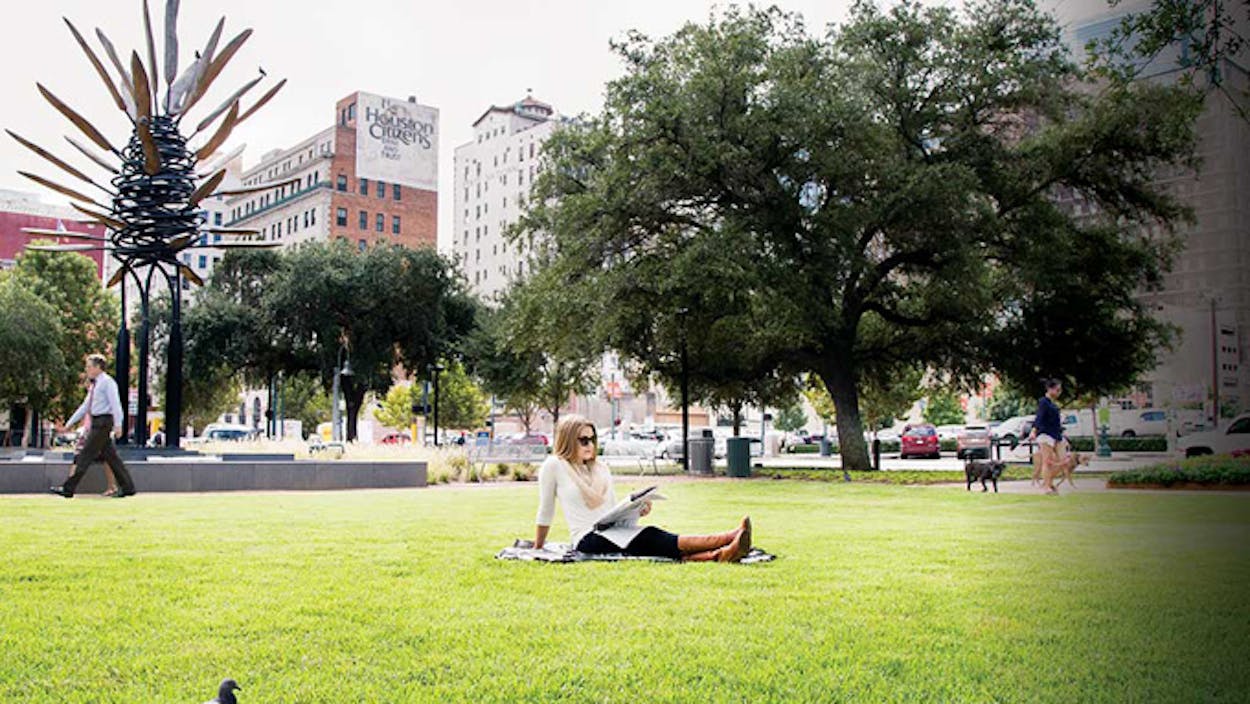On a recent weekday morning, while reading on the lawn of Market Square Park (301 Milam, 713-223-2003)—a micro-oasis of red-brick paths and art installations on the northern end of downtown Houston—I took an informal tally of my fellow park dwellers: one 6-year-old ballerina-in-training led by her parents, two retirees with matching pedometers on their waistbands, two dog owners, three dogs, one bench sitter, a dozen office workers in line for breakfast gyros, and one Downtown Street Team member in a white safari hat patrolling for litter. It was the sort of mix that would have brought a smile to an urban-living advocate like Jane Jacobs: commuters and residents, neighbors and strangers. And the scene would have been even more satisfying to a Houston history buff since it took place on one of the state’s most historically significant acres, one that, for a long, sad time, was little more than a neglected eyesore.
RELATED: The Wanderer’s Historic Downtown Houston Trip Guide
In 1836 New York developers John and Augustus Allen set out to build a great capital city befitting the five-month-old Republic of Texas. The brothers bought 6,642 acres surrounding Buffalo Bayou, the twisty, cypress-lined waterway that runs to the Gulf of Mexico, and picked this humble parcel to be the heart of the metropolis of their dreams (or schemes, some say, as the Allens were accused of overselling pestilential property).
Though Houston lost its capital designation to Austin in 1839, Market Square remained a lively nexus. “Merchants, lawyers, physicians, servant-girls and cooks . . . policemen and tramps . . . black, white, brown and yellow . . . they are all there,” observed a reporter for Harper’s in 1890. It was also the locus of civic life: four different city hall buildings stood here, three of which were lost to fires. The rubble of the last was cleared in 1960 to make way for a parking lot. By then, the ripples of progress that the Allen brothers had set in motion were growing larger and moving farther away from Market Square. As downtown’s business district expanded, residents migrated to outlying enclaves beyond Loop 610, and historic buildings were demolished in exchange for more surface parking. After-hours and on weekends, downtown was, as the former editor of Texas Architect dubbed it, the hole in the doughnut.
Even so, you could always find a good drink in Market Square. Two of the city’s cornerstones, La Carafe (813 Congress Ave., 713-229-9399) and Warren’s Inn (307 Travis, 713-247-9207), which have been in business since the fifties and late seventies, respectively, have weathered their share of booms and busts. Carolyn Wenglar, who runs both, recounts with equal matter-of-factness Liberace’s visits during the area’s late-sixties heyday and the vagrants crowding her stoops in the seventies and eighties. Though there have been several attempts since then to reboot the area’s ecosystem—including the park’s dramatic 2010 face-lift and various waves of “hot one minute, closed the next” dance clubs—a more sustainable push is being driven by a totally different breed of bar.
It all started last December with the opening of the Original OKRA Charity Saloon (924 Congress Ave., 713-237-8828) in one of the city’s oldest buildings, an 1882 barrel-vaulted beauty. Unlike previous fly-by-night ventures, OKRA is clubby only in the communal sense: it’s owned and operated by a coterie of competitors, including the Houstonians behind such beloved Montrose watering holes as Anvil (1424 Westheimer Rd., 713-523-1622), Poison Girl (1641 Westheimer Rd., 713-527-9929), and Paulie’s (1834 Westheimer Rd., 713-807-7271). Plus all proceeds go to local charities. Since then, seven other ventures have debuted in a two-block radius, including the Pastry War (310 Main), a mescal bar from OKRA president Bobby Heugel’s restaurant group; Clutch City Squire (410 Main), a “luxury dive” in an alleged former brothel; and Captain Foxheart’s Bad News Bar and Spirit Lodge (308 Main), a second-story speakeasy with an unmarked entrance. “Coming Soon” signs hang in half a dozen more storefronts in various states of renovation.
RELATED: The Wanderer’s Historic Downtown Houston Trip Guide
Just because you (re-)build it doesn’t mean they will come (back), but the new guard is personally invested. Heugel lives mere blocks from OKRA. Joshua Martinez, another of the Charity Saloon’s collaborators, retired his popular food truck, the Modular, to develop his first brick-and-mortar restaurant downtown, Goro and Gun (308 Main, 832-708-6195), now a community favorite and one of hip-hop legend Bun B’s go-to takeout spots.
Of course, the ambition for this area has often outpaced reality, dating back to the Allen brothers’ time. So stalwarts like Jim Pirtle—who has run Notsuoh (314 Main, 713-409-4750), Market Square’s most bohemian bar, since 1996—are containing their excitement. And Wenglar, downtown’s revered matriarch, believes the peaks and wanes will continue. “And I’ll still be here,” she said days before turning 78.
While businesses can be built, creating a neighborhood requires a fair amount of serendipity. To address the area’s housing shortage, there are plans to add 1,800 more apartments. In the meantime the park’s managers are trying to cultivate the square as a meeting place by organizing concerts, movies, and monthly Blanket Bingo. On a Thursday evening, nearly all the good spots on the lawn were filled with twentysomethings in their office attire, multi-dog and multi-kid families, couples on first dates, and even a curious drifter, who stood mesmerized by the DJ’s old-school turntable, which was playing Motown 45’s. As a local personality with a walrus mustache cranked the bingo cage, I took note of all the smartphones snapping photos. I did a search for #blanketbingo on Instagram and watched the evening unfold simultaneously on my screen. One user posted a shot so idyllic—tables full of people under colorful umbrellas, the sunset beaming through the leaves of an oak tree—that it could be an advertisement for Market Square’s latest transformation. But what convinced me that this revival would stick was the photo’s simple caption: “Suck it, suburbs.”
RELATED: The Wanderer’s Historic Downtown Houston Trip Guide








